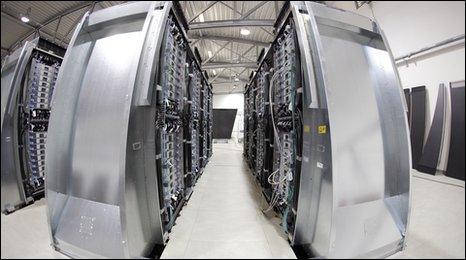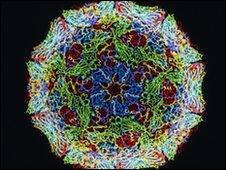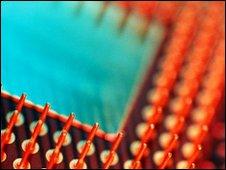Alternative supercomputer powers
- Published

Computer power does not always have to be concentrated in one room
Supercomputers are the super models of the technology world.
They get the headlines, the glossy photos and set their fans drooling over their vital statistics.
But the machines that feature on the lists of the most powerful computers on Earth are not the only powerful computers on Earth.
There are many alternative supercomputer powers that do their work without all the hoopla.
For some, the biannual Top 500 list - which ranks the fastest machines in the world - is artificial. It is as much about flag waving as it is about working out who has the biggest machine.
"You have to bear in mind that many of the big computer systems have not declared their existence," said Dr John Lockley, manager of the Oxford Supercomputing Centre. "You never get any details of those but they are big drivers of the technology."
Old iron
One of the other big pools of unseen computer power is made up of mainframes, usually IBM mainframes.

Folding@Home studies how proteins fold inside cells
These machines were the original supercomputers and until the arrival of the mini-computer and then the PC were the mainstays of the computer world.
"They are still being widely used in particular segments such as finance, retail, health and government," said Jim Porell, an IBM evangelist for the machines.
When we get cash out of an ATM, said Mr Porell, it will be a mainframe that will handle the back-end data processing of that transaction. Book an airline ticket and choose your seat on the plane and chances are that you are unknowingly using a mainframe.
The machines are being used because they are used to running constantly at nearly 100% capacity. And, said Mr Porell, they have other advantages over Intel-based racks of servers.
One IBM System z10 Enterprise Class mainframe, the biggest, is equal to 1,500 Intel servers and occupies 85% less space.
"We measure meantime between failure in decades," he said.
IBM does not say exactly how much cash is generated by selling and servicing mainframes, but the division of the company that makes them, amongst other things, was worth more than $5.2bn (£3.6bn) in the final quarter of 2009 suggesting that there are a lot of them about.
The machines range in computational power from smaller models that can manage 26 million instructions per second to the biggest machines that crank through 30 billion instructions per second. And, said Mr Porell, it is theoretically possible to chain 30 of the biggest machines together in one giant cluster.
While he admits that no-one has done that yet, some firms have amassed significant mainframe power. Giant US retail chain WalMart, said Mr Porell, has 54.
"There's one in each distribution centre to manage the assembly line that moves goods from storage out onto the tractor trailers," he said.
Many machines
Many of the supercomputers that feature on the Top 500 list are monolithic machines, usually contained within one room or facility.

Most processors spend a lot of time doing nothing
The growth of the web has given rise to more distributed ways to harness computer power - usually of the humble desktop type.
These projects typically take advantage of the fact that the processor inside most desktops spends most of its time idle. Rather than just let it sit doing nothing, it is getting increasingly easy to get it doing real scientific work.
One of the first to use that idle computer time was the Seti@Home project, which harnessed processors to look through reams of radio signals seeking signs of alien life.
Now, many more projects are keen to tap that processing power.
"Some scientists have single jobs that they need to have done very fast like simulating an explosion or something like that," said Dr David Anderson, director and developer of the Boinc distributed computing project.
"Other scientists have many, many jobs and want to complete the whole group of them relatively fast," he said.
This is where Boinc's volunteer computing project comes in. Those that download the Boinc software can offer their PC to help with one of many different scientific projects.
"Volunteer computing is by and large doing the same sort of computation that people do in supercomputer centres or other conventional hardware," said Dr Anderson.
Get enough PCs together and you can amass a significant amount of computer power, he said.
"There is in the order of 350,000 people running Boinc on their computer," he said. "We hope and expect that number will increase."
"Currently the largest supercomputers are 1-2 petaflops machines," he said. "We have 3 or 4 times as much power on tap."
The separate Folding@Home project, which is studying the ways that proteins fold inside cells, can call on about eight petaflops of computer power. Other distributed computing projects are using games consoles such as the PlayStation 3 and Xbox as sources of compute power.
"The volunteer computing approach works for a surprisingly large fraction of all scientific tasks, about 95%," said Dr Anderson. "Those that it does not work well for are ones that require individual jobs to be done as fast as possible or require large amounts of memory."
Power play
One other unmeasured pool of computer power is under the control of the net's cyber criminals.
In recent years one of the most popular hi-tech crime tactics has been to hijack home computers and put them to work for the bad guys.
A hijacked PC, typically a Windows machine, becomes part of a botnet and could be used to send out spam, as a dead drop for pirated content or as a launch platform for attacks on other websites.
Some botnets are huge. The Conficker worm is thought to have racked up millions of victims. That potentially puts more computer power than anyone has ever had in the hands of the cyber thieves.
Thankfully, so far, Conficker has not been "armed" but many other smaller botnets are regularly used. The computational power they can call on is formidable, even though it is put to nefarious ends.
"The largest botnet we've seen attack our customers has been in the hundreds of thousands of infected computers, although that was a while ago," said Paul Sop, chief technology officer at Prolexic which specialises in combating such networks.
"These days bots have more bandwidth than in the past, so a botnet with 30,000 computers can do more damage than larger botnets of the past for certain attacks," he said.
"Pretty much every week we see a botnet attacking with around 30,000 computers."
- Published31 May 2010